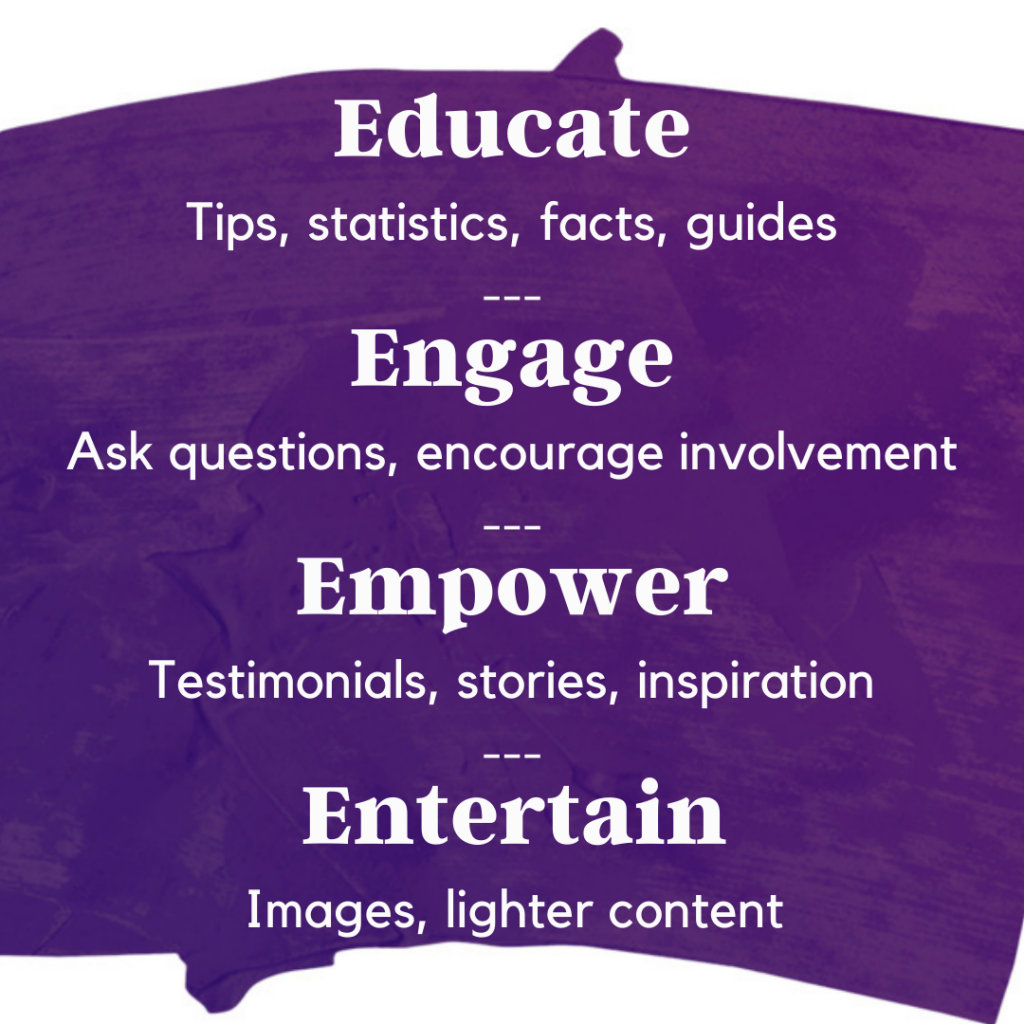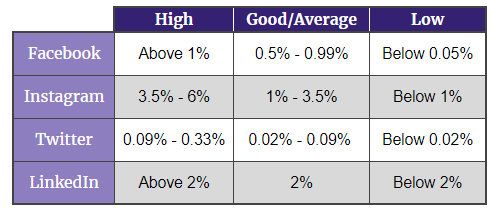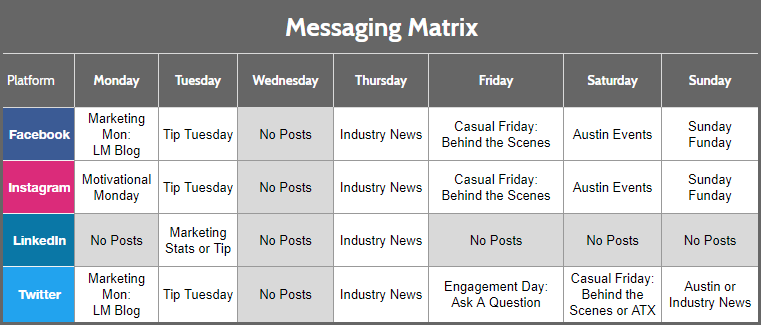In a previous post, I wrote about how social media efforts support SEO. In this post, I want to talk about how to get started with a social media strategy. Before jumping into posting on Facebook and Instagram every day, it’s important to have a clear plan for what you are going to post and when. I created the blog post off of a presentation I created for a client with a colleague that goes into more detail.
Before getting started, you need to know which platforms your audience is on and how they behave on those platforms. You need to know what kind of content resonates with them most. This is also a great way to find new opportunities for content for your blog and website.
You also want to know what platforms your competition is on, and which ones they are not — and how their fans respond to the content that they share on those platforms. Just because they are posting TikTok videos and sharing memes on Instagram does not mean that you should too.
Objectives of Social Media
Before diving into how to get started on social media, it’s important to keep in mind the core objectives of social media. Social media is intended to help you:
- Build Online Credibility
- Build & Maintain Customer Loyalty / Increase Lifetime Value
- Connect With Your Audience
- Build a Strong Organic Presence
- Stay Ahead of the Competition
There are other things that social media can do, but these are great objectives that can help you get started.
Objectives of Social Media Posts
It’s also important to keep in mind what you want to accomplish with your social media posts. Below are the Four E’s of social media posts, which are commonly cited as best practices for posts. If you are being strategic, your posts will fall into one of these four categories:

- Educate: Focus on providing valuable information to your target audience that helps them understand what you offer, what problem/pain-point you address and why they need you
- Engage: Create content that encourages your audience to provide feedback, leave comments and express their opinions. The more that they engage with your content, the more they will begin to know, like and trust your company.
- Empower: Making your audience the center of your content will empower them and can help build further credibility. You can do this by using testimonials and inspirational stories from your customers
- Entertain: Even if you are a professional organization, using humor can draw people in. There is a time and place for seriousness, but make it’s ok to have fun on social media
A mix of social posts that educate, entertain, engage and empower can help you have a strong social presence.
Social Media Competitive Analysis
To get started, make a list of your biggest competitors. I would even recommend including some companies that are not direct competitors, but are industry adjacent to the services you offer. This could help give you some fresh ideas for posts you haven’t thought of including before. For example, if you are a realtor or a real estate company, you may want to look at interior designers or even furniture companies since those are related to home ownership.
I like to make a chart for each social network. In the rows, include your company (if you have a social presence) as well as your competitors and industry relevant companies. Use a spreadsheet to keep track of your date.

In the columns, create:
- Number of Connections: This will be likes, followers, subscribers, etc. To get this number, just go to the social profile you are analyzing and look at how many connections and add it to the the appropriate cell.
- Average Engagements Per Post: In a separate spreadsheet sheet, look at the last 30-60 posts and make a list of how many engagements (likes, comments, shares) each post got. I recommend ignoring video views since those will throw off your calculations, and Instagram no longer shows how many likes a video received. Once you have numbers for the last 30-60 posts, take the average of that range to get your Average Engagements Per Post.

- Average Engagement Rate (%): For this you are wanting to figure out how many connections, on average, engage with your posts. For example, if a Company has 1500 Facebook fans, and averages 10 engagements per post, the Average Engagement Rate of their fans is 0.67% (10/1500). What you may find here is oftentimes the number of connections a profile has won’t necessarily have any correlation on engagement rate, in other words, more fans/followers does not mean a better strategy. As a rule of thumb with engagement rates
- Post Frequency: For this one, look at how often each profile is posting. Are they doing it daily or a few times a week?
Now that you have those numbers, take a close look at the type of content these companies are posting. Also look at how their fans are interacting with the content. Some things you can ask yourself:
- Are these profiles encouraging engagement? If the company page is asking a question, are people actually answering it, or are they just liking the post?
- Is there a cohesive brand identity? Ideally companies should be using custom/templated imagery that creates consistent look and feel so you can easily tell what brand it is.
- Are they doing the same or similar updates across all social networks? It’s not necessarily a bad thing, but you do want to make sure that the message is tailored to each platform and that the images being used follow best practices for proper sizes.
- Are they humanizing the brand? This can be done by highlighting employees, sharing behind the scenes images of the office and even community involvement.
- What kinds of posts do you keep seeing? These can be things like tips, blog posts, company information, testimonials, etc.
Organizing Your Social Strategy
Now that you have an idea of what works, and what doesn’t. It’s time to start building out your strategy. The first step is creating what I call the Audience Matrix. (You can also do this in a spreadsheet, and keep all of your findings together). Be sure to include each network you plan to post on and should contain these elements:
- Tone: What tone of voice each message will convey
- Type of Content Shared: In general, the kind of content that gets shared to each platform. For example, Instagram and Facebook may be a great place to share images of the office dogs, but not LinkedIn.
- Who is the Content for: Identify the kind of audience are you talking to on these platforms. For example, LinkedIn may target business professionals, while Instagram may just be for your customers.
- Purpose of the Content: What do you want to content to achieve. This ties back to the objectives of social media mentioned earlier. Each platform may have one objective, or it may have more, it just depends on what you found in your research.
Below is a sample Matrix I created for a company that you can use as a guide:

Using the Audience Matrix as a guide, you’ll want to create a Messaging Matrix. The Messing Matrix helps keep your social strategy on track so you are consistent with your messaging without being repetitive. Keep in mind the Four E’s mentioned earlier when you begin laying it out. Here are a few things to think about to help get you started:
- Create a “theme” for each day of the week to help. For example, Motivational Monday, Tip Tuesday, Engagement Wednesdays and so on.
- This should be revisited (and revised) to see what best resonates with your audience
- Remember that it is ok to take a day or two off on some networks. The lifespan of a LinkedIn post is far longer than a tweet.

Now that you have your Audience and Messaging Matrices created, you are ready to start planning out your social posts. I recommend you start out by creating batch updates. To do this, just make a running list of everything you can post for Motivational Monday, Tip Tuesday, etc. so you can quickly plug in your updates each week.
If you are using a social media scheduling platform, which I recommend, you can use their built in calendar planner, or you can use your spreadsheet. Below is a screenshot of one I’ve used off and on in the past.

Remember, social media is really about just interacting and engaging with your audience. At the end of the day, the most important thing to remember is to behave like a member first, and a brand second. Have fun with it, test often and interact with your audience. If you need help getting your strategy started, I’d love to help, feel free to contact me for more information.
